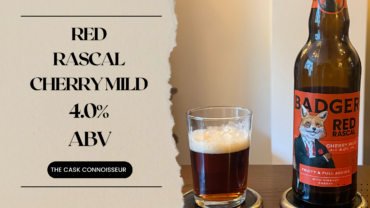What’s The Difference?
There are specific differences between Keg Ale and Cask Ale, it’s not just down to the flavour of the beer, or ingredients used, it’s also down to the nitty gritty elements of how the beer is brewed and prepared before it is able to be sold onto the bar.
Throughout this blog post, I am going to be explaining to you the main differences and similarities between these two styles of beer, I hope you’re relaxed and looking forward to reading this indulging post!
What is Cask Ale?
To put this into the most simplistic term ever, cask Aae is basically beer that has been brewed with the use of vital brewing ingredients, (I’ll run over these shortly). Then once all the ingredients have been combined together, the beer is then left fermented before being racked into 9-gallon casks, or known well as, Firkins!
Cask Ale is also established as being called Real Ale, this was once set up by the popular real ale authority, Campaign For Real Ale or CAMRA!
Cask Ale has also got one of the most visual features that can make many consumers be able to tell the difference between cask ale and keg ale and that is Co2 (Carbon Dioxide).
You see, real ale only uses the smallest amount of Co2, this is why once the beer has been pulled into the glass, you will be obliged to see any of the small tiny gas particles racing up to the top of the glass, unlike a pint of lager or keg beer, you’ll easily identify those tiny bubbles inside the glass having a little dance around.
Before I start talking about how to prepare your cask beer, let’s now look at the basic ingredients of what’s inside that glass which is full of beautiful flavours.
What is Keg Ale?
Just like Cask Ale, Keg Ale is brewed exactly the same way using the same type of ingredients, the only difference between the two is a large amount of Co2 that is used when the beer is being poured through the pumps on the bar.
Also, another partial difference is the container, unlike cask ale which is stored in firkins, keg ale most of the time once brewed and ready to be racked is transported into 11 gallons kegs, keg ale also goes through a process called cold conditioning, this is why it’s important to know that keg beer should be served at 5 degrees and cask beer should be served at 12 degrees.
Other than that, both of these beers are generically the same, but it’s now being understood and known that keg is starting to become more popular on the beverage market nowadays.
Ingredients
Like any beer or lager, the most common ingredient which is used is Barley! Before modern technology existed and also before we had something called a tractor, countrymen and women would move around the crop fields standing on tall stilts and collect the enormous amount of barley which would then be later used to create the beer.
The most common type of malts that are used to create cask ale is Pale Malt, Mild Ale Malt and Roasted Malt! These malts determine whether the beer is either a Pale Ale or a Stout!
Next, the malt is transferred into a huge mash tun along with the next vital ingredient, hops! The hops and barley when combined together deliver those gorgeous sensational aromas, just like barley malt, there are many types of hops, here are some examples: Fuggle, Citra and Cascade and of course there is loads more, why not check out the many different types of hops available on The British Hop Association!
So how do people know what hops go with what beer, well it’s easy to understand? Let’s take Citra which is brewed by Oakham Ales, this beer uses Citra hops which delivers that refreshing sweet citrusy taste and that’s what makes this beer taste absolutely amazing.
Without these two ingredients, it’s physically impossible to make cask or keg beer, unless it’s gluten-free, this is when there is no barley added!
Hops
Barley
Preparing The Beer
I’ll begin with cask ale, as soon as the beer has arrived at your cellar, it’s important to rack the beer as soon as possible, this is so that the sediment (finings) inside the cask can settle towards the bottom of the firkin. Once that step is completed, it is important and I must reiterate this, the casks should not be disturbed for 24 hours!
After 24 hours and the beer has been settled overnight after being rolled around the day before, it’s time to vent the beer at the seal on the firkin, this is found at the top. Now just to bear in mind, most cellars use something called automatic stillage this is where the cask is resting on its belly horizontally, but some pubs also use vertical stillage, this is where the cask is left standing upwards.
If in your local pub or cellar and they use vertical stillage, venting the cask is not required!
To vent a cask, or you need is a wooden mallet, hardwood spile (hard peg) and then a cane porous spile (soft peg), once you’ve gently tapped the hard peg into the top of the firkin, this can then be removed and thrown away, the soft peg is then inserted and once again the cask needs to be left unattended for the next 24 hours.
To avoid infection to the beer, once the peg has been used, it has to be disposed!
After another 24 hours, it’s now time to tap your beer! Using your wooden mallet, you need to strike at the keystone which is on the front of the cask and gently hit the tap into the cask. Once this step has been completed, again the beer has to be left, this is because the beer inside has to be disturbed in order for you to prepare it!
After the final 24 hours, it’s now time to check your beer, you need to be looking for 3 key features:
- Clarity – Does the beer look clear, if so move on to the next feature! Sadly if the beer is still cloudy and you can still see bits of sediment floating around in the glass, then the beer needs to be left for another couple of hours.
- Aroma – What does the beer taste like? Is it fruity/sweet, if so your beer is partially ready! However, what about if there is a vinegar smell, this means sadly the beer is off and has to be thrown away!
- Taste – Does the beer have those sensational flavours, is there a hoppy, malty taste, if so your beer is ready to be poured onto the bar. On the other hand, the beer tastes sour, sadly once again, the batch that you may have received is off and has to be thrown away.
Now, looking at Keg Ale things work a little bit different, unlike cask beer where the beer has to be left and not disturbed for three days, as soon as your keg ale delivery has arrived at your cellar, the beer can be served straight away! There is no mallet needed or any pegs, or that is required is basically a keg coupler which sits on top of the keg and then is twisted and pull downwards and then happy drinking.
You’ll notice on the picture above, two white screw nuts, one of these screws is for your beer pipe and the other is for the gas pipe! If any of these become damaged then you won’t be able to dispense any beer.
Beer O Clock
After completing all of these steps on the preparation of your beer, it is now all ready to be served to your general customers and you can finally commence the happy drinking!
Just before I end this post, I want to leave you all with 2 key pointers which is vital for any bar/cellar environment!
- Once the beer has been attached to the bar and is ready for general sale, it’s important that the beer in the firkin and keg is fully consumed within 3-5 days, this is because the beer starts to wear off and becomes old!
- The most important pointer is all about keeping your beer lines clean, clean lines mean better beer quality!
This now completes my latest post, I really hope you’ve all enjoyed reading it! If you have any questions, that you would like to ask me, please do post them in the comments, until next time everyone, have a fantastic Bank Holiday Weekend!
Cheers





6Comments
May 28, 2021 at 10:42 am
I did a whole course in cellar management and beers etc as part of one of my older jobs and loved it. This was just like that but without the beer to drink at the same time!
Rosie
May 28, 2021 at 12:46 pm
I found it very interesting when I did my course, it was really enjoyable. I hope you really enjoyed this post 😁
May 28, 2021 at 10:53 am
Hey Luke. Very interesting read – you’ll make experts of us all yet! There’s no rushing with the preparation process is there? Good things come to those who wait 😉
May 28, 2021 at 12:46 pm
Couldn’t agree more Richie, it’s important to be patient when it comes to the preparation of real ale 😁
May 28, 2021 at 9:36 pm
As with all good things, it sounds like Keg ale is the less delicate and involved process and can be consumed straight away, making it easier to get into the hands of pub goers. While I have nothing against something more convenient, I love that cask ale requires more attention and finesse. The patience factor always attracts me.
Thanks for sharing an informative and well-written guide!
May 30, 2021 at 12:19 am
I believe this is why many people enjoy cask ale because it has to be truly and well looked after. I’m really glad you enjoyed reading this post 😁